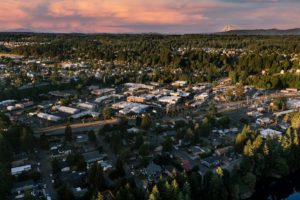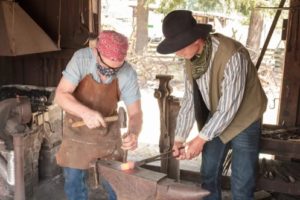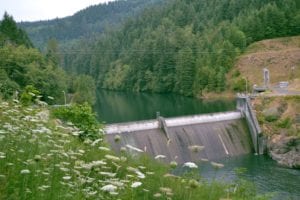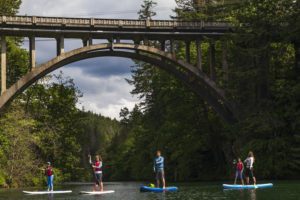
For this generation or the next, long-time residents or new arrivals, Estacada is a unique and wonderful place to call home and conduct business. It’s a place where ‘community’ has a very special meaning, where loggers, farmers, artists, musicians, manufacturers and business people live side by side in a sort of eclectic harmony. It’s a place where you expect to bump into your neighbors at the hardware store and inquiries about your well being are sincere. Perhaps not everyone knows your name, but many do. We take care of each other. A bit quirky, yes. Definitely unexpected. And absolutely unforgettable.
HISTORY
 The Estacada area’s banks and fertile valleys adjacent to the Clackamas River were seasonal Clackamas Indian settlements providing abundant fishing, hunting and berry harvesting for thousands of years. Estacada was sparsely settled by emigrants arriving on the Barlow Road segment of the Oregon Trail in the mid-to-late 1800s, unlike nearby Eagle Creek, which was a thriving community with a dance hall, saloons, a store, mills, schools and a post office.
The Estacada area’s banks and fertile valleys adjacent to the Clackamas River were seasonal Clackamas Indian settlements providing abundant fishing, hunting and berry harvesting for thousands of years. Estacada was sparsely settled by emigrants arriving on the Barlow Road segment of the Oregon Trail in the mid-to-late 1800s, unlike nearby Eagle Creek, which was a thriving community with a dance hall, saloons, a store, mills, schools and a post office.
 Estacada came into its own in 1903 with the building of Cazadero Dam, the first hydroelectric power plant on the Clackamas River, followed by Faraday and River Mill dams. Estacada’s post office was established in 1904 and the town became official in 1905. Oregon Power Townsite Company officials tossed names into a hat and the unusual name chosen was George J. Kelly’s suggestion of “Llano Estacado” after an area in Texas. Llano estacado, is “palisaded plain” in Spanish. It is unknown whether the “o” at the end was changed to an “a” inadvertently or on purpose. Suggestions that the town was named after a civic leader’s daughters, Esther and Katie, are unsubstantiated.
Estacada came into its own in 1903 with the building of Cazadero Dam, the first hydroelectric power plant on the Clackamas River, followed by Faraday and River Mill dams. Estacada’s post office was established in 1904 and the town became official in 1905. Oregon Power Townsite Company officials tossed names into a hat and the unusual name chosen was George J. Kelly’s suggestion of “Llano Estacado” after an area in Texas. Llano estacado, is “palisaded plain” in Spanish. It is unknown whether the “o” at the end was changed to an “a” inadvertently or on purpose. Suggestions that the town was named after a civic leader’s daughters, Esther and Katie, are unsubstantiated.
 The railroad built to access the dam and the small community of Cazadero, opened up the vast wilderness of Douglas fir and western red cedar to logging, as well as providing transportation for agriculture and passengers. By the 1920s Estacada was a resort destination, far eclipsing Eagle Creek, with a riverside park, dance hall, a grand hotel, stores, saloons, and five electric trolleys daily to and from Portland. Amazingly, the town also was the largest exporter of ginseng in the United States. Yes, ginseng!
The railroad built to access the dam and the small community of Cazadero, opened up the vast wilderness of Douglas fir and western red cedar to logging, as well as providing transportation for agriculture and passengers. By the 1920s Estacada was a resort destination, far eclipsing Eagle Creek, with a riverside park, dance hall, a grand hotel, stores, saloons, and five electric trolleys daily to and from Portland. Amazingly, the town also was the largest exporter of ginseng in the United States. Yes, ginseng!
Rail use declined with the advent of the automobile, and the Great Depression took its toll on agriculture export and tourism. Logging kept the economy vital until the 1970s.
ESTACADA TODAY
With a population of 5000+ and growing, Estacada is committed to economic growth while protecting its small town appeal and values. In the past decade Estacada has revitalized its downtown core, expanded industrial business park, increased manufacturing jobs and the Chamber’s tourism, Visit Estacada, has established itself as a tourist destination in its own right.
Estacada offers a unique blend of history, culture and recreation. It is home to hundreds of artists, musicians and writers. With more than 25 larger than life, Insta-worthy murals that capture and celebrate Estacada’s rich heritage, the town is literally an outdoor gallery. Even the bike racks are works of art in town.
Estacada sits on the bank of the wild and scenic Clackamas River and at the base of the majestic Mt. Hood National Forest. With more than a million acres of untamed wilderness, in our backyard, the area attracts thousands of visitors and outdoor enthusiasts each year.
